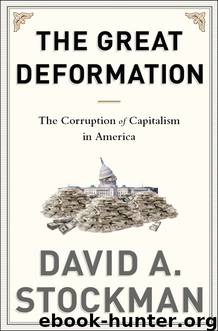The Great Deformation by David Stockman

Author:David Stockman [Stockman, David A.]
Language: eng
Format: epub
ISBN: 9781586489137
Publisher: PublicAffairs
CHAPTER 18
THE GREAT DEFORMATION
OF CAPITAL MARKETS
How Wall Street Got Huge
THE COLLAPSE OF THREE SEPARATE $5 TRILLION FINANCIAL BUBBLES in less than a decade attested to the deeply impaired condition of the nation’s capital markets. Yet the spectacular round-trips of the S&P 500 and Case–Shiller housing price index were not the only progeny of the Fed’s bubble finance. There was actually an even greater deformation lurking beneath these wild rides; namely, the aberrant journey of the giant government bond market which forms the foundation of Wall Street and drives the financial rhythms by which it operates.
During the 1970s the financial system, in the aftermath of Camp David, endured the near-destruction of the government bond market. But then for the following thirty years it was favored with continuously rising bond prices constituting not only the greatest uninterrupted market rally in financial history, but also the greatest deformation.
It instilled in Wall Street the utterly false lesson that fortunes can be made in the carry trade, an illusion that is possible only when the Treasury bond price keeps rising, rising, and rising. Yet under a régime of sound money it is not possible for public debt to appreciate for long stretches of time, and most certainly not for thirty years.
THE GLORIOUS REIGN OF THE BRITISH CONSOL: GOVERNMENT BONDS IN THE ERA OF SOUND MONEY
This truth is illustrated by the glorious reign of the 3 percent British consol, a perpetual bond of the British government. First issued in 1757, it remained in circulation until 1888. Other than temporary wartime fluctuations, the price of the 3 percent consol did not change for 131 years. Accordingly, no punter got rich riding the consol on leverage, yet no saver lost his shirt by owning it for its yield. The consol was a sound public bond denominated and payable in sound money.
After August 1971, by contrast, the US Treasury bond became the “anti-consol”; that is, the poker chip of speculators, not the solid redoubt of savers. The thing to do was to short it during the 1970s when the Great Inflation crushed its value; own it during the 1980s and 1990s when disinflation lifted its price; and rent it after December 2000 when well-telegraphed bond-buying campaigns by the central bank made holding the bond a front runner’s dream.
The crucial difference between the stable era of the consol and the volatile era of the anti-consol, of course, is the monetary standard. The gold content of the pound sterling did not change for 131 years; in fact, not for 212 years. By contrast, for the last forty years the dollar has had no content at all, aside from the whim of the FOMC. Needless to say, what is implicated here is far more than “fun facts” about the classical gold standard.
The era of the anti-consol demonstrates that capital markets eventually lose their capacity to honestly price securities under a régime of unsound money; they end up dancing to the tune of the central bank; that is, pricing the trading value of
Download
This site does not store any files on its server. We only index and link to content provided by other sites. Please contact the content providers to delete copyright contents if any and email us, we'll remove relevant links or contents immediately.
The Secret History by Donna Tartt(16623)
The Social Justice Warrior Handbook by Lisa De Pasquale(11489)
Thirteen Reasons Why by Jay Asher(7788)
This Is How You Lose Her by Junot Diaz(5772)
Weapons of Math Destruction by Cathy O'Neil(5037)
Zero to One by Peter Thiel(4824)
The Myth of the Strong Leader by Archie Brown(4789)
Promise Me, Dad by Joe Biden(4447)
Beartown by Fredrik Backman(4419)
Stone's Rules by Roger Stone(4415)
How Democracies Die by Steven Levitsky & Daniel Ziblatt(4399)
The Fire Next Time by James Baldwin(4343)
100 Deadly Skills by Clint Emerson(4079)
A Higher Loyalty: Truth, Lies, and Leadership by James Comey(4033)
Rise and Kill First by Ronen Bergman(4012)
The David Icke Guide to the Global Conspiracy (and how to end it) by David Icke(3882)
The Farm by Tom Rob Smith(3872)
Secrecy World by Jake Bernstein(3782)
The Doomsday Machine by Daniel Ellsberg(3731)
